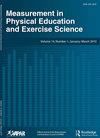Linking Vertical Jump and Standing Broad Jump Tests: A Testing Equating Application
IF 1.9
4区 教育学
Q2 EDUCATION & EDUCATIONAL RESEARCH
Measurement in Physical Education and Exercise Science
Pub Date : 2022-08-22
DOI:10.1080/1091367X.2022.2112683
引用次数: 4
Abstract
ABSTRACT This study evaluated test-equating methods to enable comparisons and conversions between the vertical jump (VJ) and standing long jump (SLJ) tests. A total of 528 youth (280 males) performed VJ and SLJ, and their scores were randomly split as the calibration (C) sample (n = 478) and cross-validation (CV) sample (n = 50). SLJ scores of the C sample were equated to the scale of VJ using linear and equipercentile equating, and established conversion between the tests was applied to SLJ scores of the CV sample. Overall, the correlations between VJ and equated VJ were moderately high to high and the absolute differences were small in both C and CV samples. There was little difference between the equating methods, but the results of the equipercentile method were used because it could provide a more robust conversion in theory. The conversion should be further crossly validated with large, more diverse samples.纵跳和立定跳远联动测试:一个测试等式的应用
摘要:本研究评估了测试等同方法,以实现垂直跳远(VJ)和立定跳远(SLJ)测试之间的比较和转换。共有528名青年(男性280人)进行了VJ和SLJ测试,其得分随机分为校正(C)样本(n = 478)和交叉验证(CV)样本(n = 50)。采用线性和等百分位方程将C样本的SLJ得分等同于VJ量表,并将检验之间建立的转换应用于CV样本的SLJ得分。总体而言,VJ和等价VJ之间的相关性中等至高,C和CV样本的绝对差异很小。虽然两种等价方法之间的差异不大,但我们采用了等百分位法的结果,因为它在理论上可以提供更鲁棒的转换。转换应进一步交叉验证与大,更多样化的样本。
本文章由计算机程序翻译,如有差异,请以英文原文为准。
求助全文
约1分钟内获得全文
求助全文
来源期刊

Measurement in Physical Education and Exercise Science
Medicine-Orthopedics and Sports Medicine
CiteScore
4.20
自引率
33.30%
发文量
24
期刊介绍:
The scope of Measurement in Physical Education and Exercise Science (MPEES) covers original measurement research, special issues, and tutorials within six substantive disciplines of physical education and exercise science. Six of the seven sections of MPEES define the substantive disciplines within the purview of the original research to be published in the journal: Exercise Science, Physical Activity, Physical Education Pedagogy, Psychology, Research Methodology and Statistics, and Sport Management and Administration. The seventh section of MPEES, Tutorial and Teacher’s Toolbox, serves to provide an outlet for review and/or didactic manuscripts to be published in the journal. Special issues provide an avenue for a coherent set of manuscripts (e.g., four to five) to collectively focus in-depth on an important and timely measurement-related issue within the scope of MPEES. The primary aim of MPEES is to publish high-impact manuscripts, most of which will focus on original research, that fit within the scope of the journal.
 求助内容:
求助内容: 应助结果提醒方式:
应助结果提醒方式:


